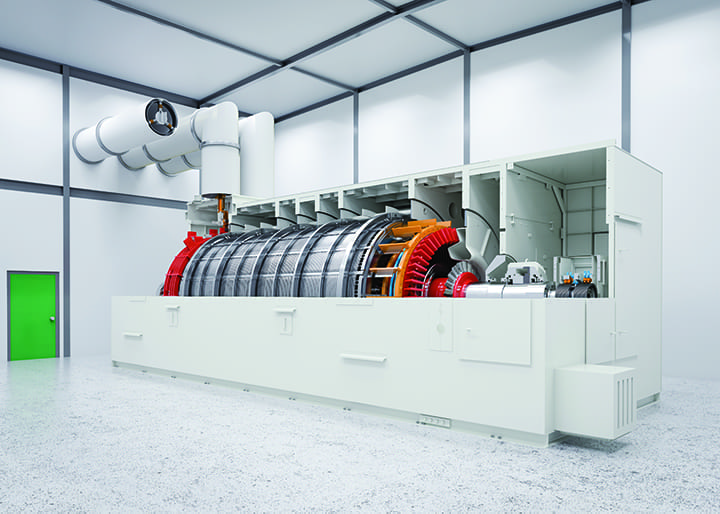Inertia and the Power Grid: Should We Be Worried About System Stability?
Credit to Author: Aaron Larson| Date: Thu, 01 Jun 2023 04:29:14 +0000

One concern some observers raise about the growth of inverter-based resources, such as solar, wind, and battery storage, supplying the power grid is that they don’t provide inertia. Inertia has historically been a key source of grid reliability.
Inertia in power systems refers to the energy stored in large rotating generators and some industrial motors, which gives them the tendency to remain rotating. Conventional fossil, nuclear, and hydropower generators provide abundant inertia, and thus, it has long been taken for granted that sufficient inertia would be available for stable and reliable system operation.
If a large power generator trips offline due to a fault or malfunction, the inertia contained in other large generators synchronized to the grid can temporarily make up for the power lost from the failed generator. This temporary response—which is typically available for a few seconds—keeps grid frequency more stable while allowing mechanical systems that control most power plants time to detect and respond to the failure.
Measuring Inertia
Because inertia is so important for grid operation, Reactive Technologies, a grid resilience tech company, created what it calls a “first-of-its-kind grid inertia measurement tool.” Reactive’s GridMetrix platform “provides new levels of visibility to grid operators,” according to the company, replacing estimates and modeling of inertia and other functions, “enabling better planning for reliability and high utilization of renewable power.” A trial project featuring the technology is currently slated for deployment in Australia.
“Until recently, operators relied on modeling and estimations to ensure the grid remained stable,” Marc Borrett, CEO and co-founder of Reactive Technologies, told POWER. He explained that Reactive’s pioneering technology directly measures inertia and system strength by sending pulses of power through the grid, which are measured and processed by the company’s grid edge measurement devices and its GridMetrix cloud computing platform.
“Using GridMetrix, operators can now accurately map any deviations in power system stability, allowing an almost instantaneous response to keep the grid secure,” Borrett said. “The GridMetrix technology is completely unique in the industry and is the only solution capable of measuring inertia and system strength levels in real-time. Through real-time measurement, significant value can be unlocked for grid operators.”
Borrett further explained, “By now being able to measure the entire energy system, that is, beyond the transmission system infrastructure and into the parts of the network with non-synchronous generation and demand-side loads, Reactive makes it possible to directly measure the hidden inertia in the distribution grid, which in some cases can account for up to 30% of the total share of inertia. Directly measuring this hidden capacity creates extra capacity for grid operators to now safely use to integrate more renewables and, as a result, help to enable a safer, faster transition to an ultra-low-carbon power grid while maintaining system stability.”
Speed of Detection and Response Is the Key
Yet, according to a technical report published by the National Renewable Energy Laboratory (NREL), decreasing levels of inertia may not be as big of a problem as some people suggest. The report, titled Inertia and the Power Grid: A Guide Without the Spin, explains that inertia is only one of several grid services that help maintain power system reliability. “The importance of inertia to a power system depends on many factors, including the size of the grid and how quickly generators in the grid can detect and respond to imbalances. A grid with slower generators needs more inertia to maintain reliability than a grid that can respond quickly,” the report says.
One of the key takeaways from the report is that inverter-based resources have the ability to quickly detect frequency deviations and respond to system imbalances using power electronics. “Tapping into electronic-based resources for this ‘fast frequency response’ can enable response rates many times faster than traditional mechanical response from conventional generators, thereby reducing the need for inertia,” the authors explained.
Furthermore, there are two counterbalancing effects of replacing conventional generators with inverter-based resources. While inverter-based resources decrease the amount of inertia available, they also reduce the amount of inertia actually needed, which offsets the first effect. “In combination, this represents a paradigm shift in how we think about providing frequency response,” the report notes.
The NREL report says ongoing research “points to the possibility of maintaining grid frequency even in systems with very low or no inertia.” The development of new “grid-forming” inverters enable inverter-based resources to take a more active role in maintaining reliability and could be an integral technology for “a purely inverter-based grid.”
In the meantime, Reactive’s Borrett said his company’s technology is uncovering other important grid management information that could assist operators. “As Reactive works with increasingly more and more grid operators around the world, its measurement systems are increasingly able to identify further phenomena, which have otherwise been hidden or undetectable, leading to an increasingly deeper understanding of what it will take to decarbonize the power system while maintaining security and reliability.”
The big takeaway is that although growth in inverter-based resources will reduce the amount of grid inertia, there are multiple solutions for maintaining or improving system reliability. Therefore, declines in inertia do not pose significant technical or economic barriers to significant growth in wind, solar, and storage, and do not gravely threaten the reliability and stability of the U.S. power grid.
—Aaron Larson is POWER’s executive editor.
The post Inertia and the Power Grid: Should We Be Worried About System Stability? appeared first on POWER Magazine.